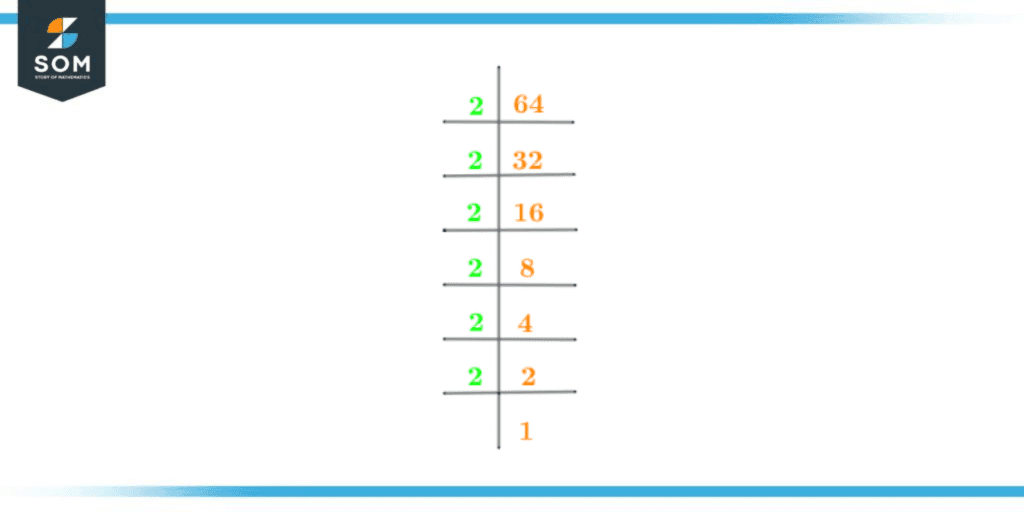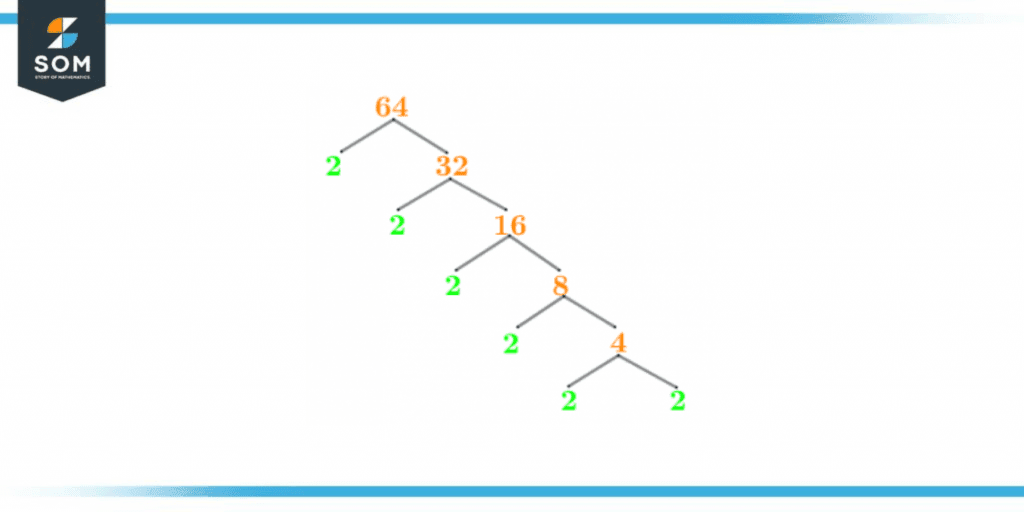JUMP TO TOPIC
Factors of 64: Prime Factorization, Methods, Tree, And Examples
The factors of 64 are the numbers that yield zero as the remainder when 64 is divided from such numbers. Not only do these factors produce zero as the remainder, but the list of factors also includes those numbers which give 64 as the product when multiplied together.

Figure 1 – All possible Factors of 64
The number 64 is an even composite number so which indicates that the number 64 consists of multiple factors and being an even number, it also consists of 2 as one of its factors.
There are multiple methods for determining the factors of a number, such as the division method and the prime factorization method, but one of the easiest methods is the division method.
In the division method, all those numbers which produce zero as the remainder are considered factors. Apart from the remainder, these numbers also produce a whole number quotient. In such a case, both the divisor and the quotient act as factors.
Let’s consider the division of 64 with 2 for clarification:
\[ \frac{64}{2} = 32 \]
Since a whole number quotient is produced, so both 2 and 32 are the factors of 64.
In this article, we will learn all about the factors of 64 and the various techniques which can be used to determine these factors 64.
What Are the Factors of 64?
The factors of 64 are 1, 2, 4, 8, 16, 32, and 64. These are the numbers that generate zero as the remainder whenever 64 is divided from these numbers. So in total, the number 64 consists of 7 factors.
In the factors of 64, the smallest factor is the number 1 and the largest factor is the number itself.
How To Calculate the Factors of 64?
You can calculate the factors of 64 by both the prime factorization method and the division method. But before determining the factors of 64, it is necessary to determine the range in which these factors lie.
An easy way to determine this range is to look for a number that is half of 64. Since the half of 64 is 32, so the factors of 64 will lie between this half number and the smallest factor.
As mentioned above, the smallest factor for any number is the number 1 itself. So, in this case, the range of factors will lie between 1 and 32. Since there are two basic methods for determining the factors, let’s first consider the division method.
According to the division method, the necessary condition for a number to be a factor is that it needs to yield zero as the remainder and also needs to produce a whole number quotient. Keeping these two conditions in mind, let’s take a look at some potential factors of 64:
\[ \frac{64}{2} = 32\]
Since a whole number quotient is produced, this division indicates that both 2 and 32 are factors of 64.
Let’s consider the division of all the factors:
\[ \frac{64}{4} = 16\]
\[ \frac{64}{8} = 8\]
\[ \frac{64}{16} = 4\]
\[\frac{64}{32} =2 \]
\[\frac{64}{64} =1\]
So, the list of all the factors of 64 is given below:
Factors of 64: 1, 2, 4, 8, 16, 32, and 64.
Hence, the number 64 has 7 factors, where the smallest factor is 1 and the largest factor is the number itself, in this case, 64.
Factors of 64 by Prime Factorization
Prime Factorization is a division technique in which the division is only carried out with the help of prime numbers. In prime factorization, the process of division continues until 1 is achieved at the end.
The method of prime factorization also helps to determine the prime factors for a number. In prime factorization, the quotient acts as the dividend until the result,1, is achieved.
In the case of the number 64, the prime factor for 64 is 2. The prime factorization for 64 begins with 2 as a divisor for 64 and continues till 1 is obtained at the end.
A mathematical representation of the prime factorization of 64 is shown below:
64 $\div$ 2 = 32
32 $\div$ 2 = 16
16 $\div$ 2 =8
8 $\div$ 2 = 4
4 $\div$ 2 = 2
2 $\div$ 2 =1
This prime factorization can also be expressed in the form of a single equation as shown below:
\[ \text{Prime Factorization of 64} = 2^{6} \]
The prime factorization of 64 is also shown below:

Figure 2 – Prime Factorization of 64
Factor Tree of 64
A factor tree is a visual representation of the prime factorization for any number. The only notable difference between prime factorization and factor tree is that the prime factorization procedure continues till 1 is achieved at the end whereas the facto tree ends at prime numbers.
The factor tree begins with the number itself and then extends its branches into a prime factor and a whole number quotient. This quotient then acts as the dividend and extends its branches.
This branch extension comes to an end when prime factors are obtained at the end branches.
For the factor tree of 64, the initial branches will extend out from 64 and will continue till prime factors are obtained at the end. The factor tree for the number 64 is shown below in figure 2:

Figure 3 – Factor Tree of 64
Factors of 64 in Pairs
A factor pair is a pair of numbers that when multiplied together give the original number as the product. In the case of the number 64, the factor pairs consist of all the factors that give 64 as the result when these factors are multiplied by each other.
The factor pairs for any number can be both positive as well as negative. The only difference between the positive and negative factors is that of the sign with the factors.
Since the number 64 has 7 factors in total so their factor pairs are given below:
1 x 64 = 64
2 x 32 = 64
4 x 16 = 64
8 x 8 = 64
So there are 4 positive factor pairs of the number 64. These positive factor pairs are:
Factor pairs of 64 = (1, 64), (2, 32), (4, 16), (8, 8)
Now, let’s take a look at the negative factor pairs:
-1 x -64 = 64
-2 x -32 = 64
-4 x -16 = 64
-8 x -8 = 64
One thing to note about the negative factor pairs is that both the numbers within the pair need to have negative signs so when they get multiplied together, they yield a positive product.
The negative factor pairs of 64 are given below:
Negative Factor pairs of 64 = (-1, -64), (-2, -32), (-4, -16), (-8, -8)
Factors of 64 Solved Examples
To further strengthen the concept of the factors of 64, let’s take a look at some simple examples concerning the factors of 64.
Example 1
Calculate the total number of factors of 64 through the factorization method.
Solution
The factors of a number can be found through the factorization method. To determine the total number of factors through this method, simply note down its factorization.
The factorization of 64 is given as:
Factorization = 1 x 2$^{6}$
To calculate the total number of factors, add 1 to all the exponents of the factors and then multiply these factors together.
The exponent of 1 is 1 and the exponent of 2 is 6 so adding 1 in each of these exponents and then multiplying them together gives the number 14. Hence, the number 64 has 14 factors in total, of which 7 factors are positive and 7 are negative.
Positive Factors of 64 = (1, 64), (2, 32), (4, 16), (8, 8)
Negative Factors of 64 = (-1, -64), (-2, -32), (-4, -16), (-8, -8)
Example 2
Calculate the average of all the factors of 64.
Solution
To calculate the average of all the factors of 64, let’s first list down the factors of 64.
The factors of 64 are:
Factors of 64 = 1, 2, 4, 8, 16, 32, 64
For determining the average, use the formula given below:
\[ \text{Average} = \frac{\text{Sum of all the factors}}{\text{Total number of factors}} \]
\[ \text{Average} = \frac{1+2+4+8+16+32+64}{7} \]
\[ \text{Average} = \frac{127}{7} \]
Average = 18.14
Hence, the average of all the factors of 64 is 18.14.
Example 3
Calculate the sum of all the factors of 64. Also, separate the odd and even factors.
Solution
To calculate the sum of all the factors of 64, let’s first list down all these factors. These are given below:
Factors of 64 = 1, 2, 4, 8, 16, 32, 64
The sum of these factors is given as:
Sum of factors of 64 = 1 + 2 + 4 + 8 + 16 + 32 + 64
Sum of factors of 64 = 127
Hence, the sum of all the factors of 64 is 127.
Now, let’s separate the factors of 64.
Odd factors are given below:
Odd factors = 1
Even factors are given below:
Even factors = 2, 4, 8, 16, 32, 64
Hence, the number 64 has 6 even factors and only 1 odd factor.
All images / mathematical drawings are created with GeoGebra.
